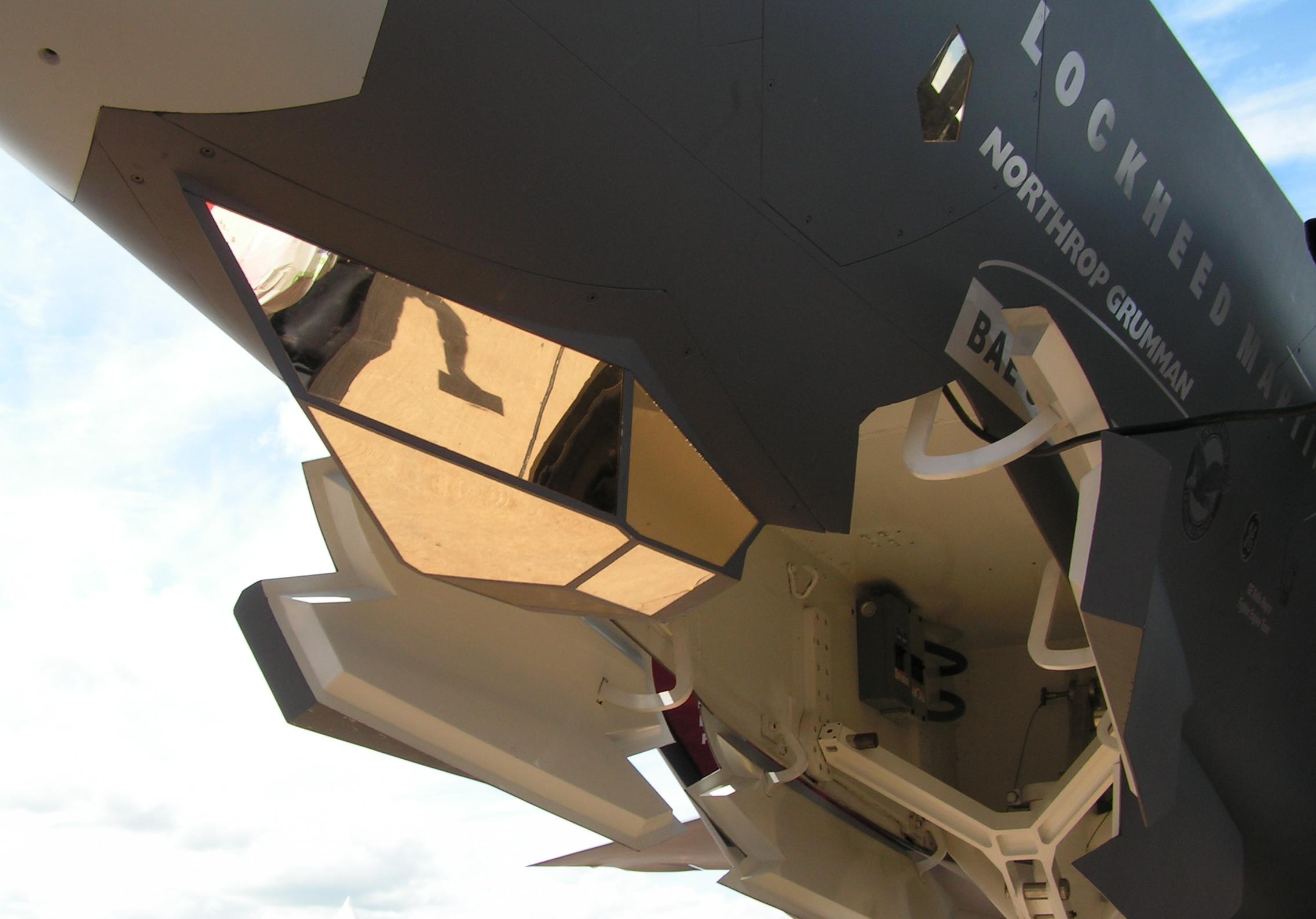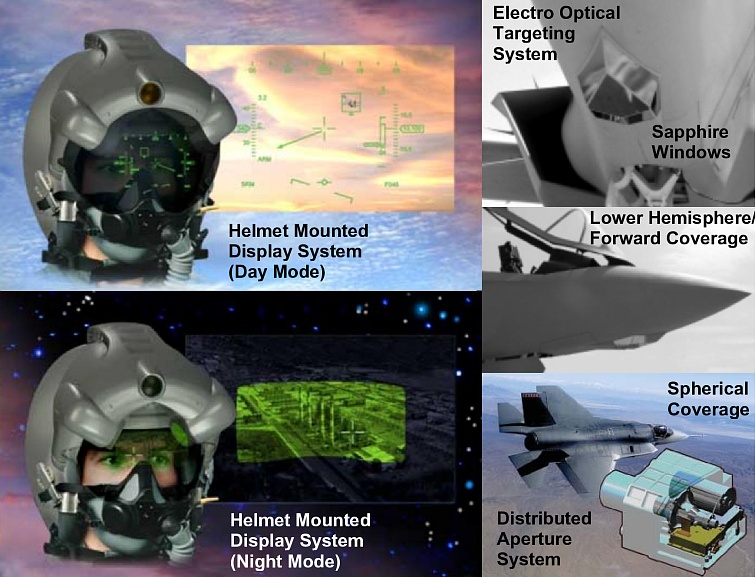 |
| Sapphire Window Structure |
“The F-35 will, in my opinion, be 10 years behind legacy fighters when it achieves [initial operational capability],” said one Air Force official affiliated with the F-35 program. “When the F-35 achieves [initial operational capability], it will not have the weapons or sensor capability, with respect to the CAS [close air support] mission set, that legacy multi-role fighters had by the mid-2000s.”
The problem stems from the fact that the technology found on one of the stealth fighter’s primary air-to-ground sensors—its nose-mounted Electro-Optical Targeting System (EOTS)—is more than a decade old and hopelessly obsolete. The EOTS, which is similar in concept to a large high-resolution infrared and television camera, is used to visually identify and monitor ground targets. The system can also mark targets for laser-guided bombs.
[Stealth requires internal mounting of sensors on the JSF as opposed to podded mount on previous fighters.] Ironically, older jets currently in service with the Air Force, Navy and Marine Corps can carry the latest generation of sensor pods, which are far more advanced than the EOTS sensor carried by the F-35. The latest generation pods—the Lockheed Martin Sniper ATP-SE and Northrop Grumman LITENING-SE—display far clearer high-definition video imagery in both in the infrared and optical spectrum—and from greater distances. Further, both pods have the ability to beam those full-motion video feeds to ground troops, which provides those forces with vital intelligence information.
F-35 Lightning II JSF | Info, Variants, AN/APG-81, Costs/Budget, Specs
The F-35 is equipped with the following sensor systems
- the Northrop Grumman
- AN/APG-81 AESA radar system and
- AN/AAQ-37 Electro-Optical Distributed Aperture System (EO DAS).
- The F-35 pilot will wear a helmet-mounted display system (F-35 HMDS) from VSI (VSI is a joint venture between Elbit Systems and Rockwell Collins).
- The targeting system on the F-35 is the nose-mounted Lockheed Martin AN/AAQ-40 Electro-Optical Targeting System (EOTS).
- The F-35's self-protection system is the BAE Systems AN/ASQ-239 Barracuda, an improved version of the F-22's AN/ALR-94 EW suite.
The F-35's sensor and communications suite has situational awareness, command-and-control and network-centric warfare capabilities.[206][306]
- The main sensor on board is the AN/APG-81 AESA-radar, designed by Northrop Grumman Electronic Systems.[307]
- It is augmented by the nose-mounted Electro-Optical Targeting System (EOTS),[308] it provides the capabilities of an externally mounted Sniper XR pod with a reduced radar presence.[309][310]
- The AN/ASQ-239 (Barracuda) system is an improved version of the F-22's AN/ALR-94 EW suite, providing sensor fusion of RF and IR tracking functions, basic radar warning, multispectral countermeasures for self-defense against missiles, situational awareness and electronic surveillance; employing 10 radio frequency antennae embedded into the edges of the wing and tail.[311][312]
- Six additional passive infrared sensors are distributed over the aircraft as part of Northrop Grumman's electro-optical AN/AAQ-37 Distributed Aperture System (DAS),[28] which acts as a missile warning system, reports missile launch locations, detects and tracks approaching aircraft spherically around the F-35, and replaces traditional night vision goggles. All DAS functions are performed simultaneously, in every direction, at all times.
- The Electronic Warfare systems are designed by BAE Systems and include Northrop Grumman components.[313]
 |
What's Inside F-35's EOTS |
 |
| Faceted Sapphire window passes 85% EO/IR |
Aiming weapons from a stealth aircraft like the F-35 is not easy. The infrared sensors used to find targets in the air and on the ground need a 360-degree view, so they must hang outside the airframe. However, the shape of any exterior hardware produces a telltale signature on enemy radar, so Lockheed Martin engineers put the targeting optics in a multifaceted sapphire structure jutting out of the fuselage under the aircraft's nose. "The material is the same as you find in a supermarket checkout bar-code scanner," says Don Bolling, Lockheed's business development manager for the electro-optical targeting system (EOTS). From the outside, the beveled shape of the damage-resistant panels will reflect radar in meaningless patterns, in the same way the airplane's other surfaces are shaped to defeat enemy tracking. Inside, a focal-plane array produces two kinds of infrared images: high-resolution images for targeting, and less distinct "search and track" images to follow distant objects of interest.
|
Laser Assembly Diode-pumped laser finds the range of targets and designates and guides smart weapons. |
Fiberoptic Link Connects the sensor to the airplane's central computer. |
360-degree Gimbal Assembly Passive sensors turn to capture thermal images of targets. |
|
Range Receiver Measures the reflected laser to gauge distance. |
Spot Tracker Allows airplane to see ground troops' or another aircraft's targeting lasers. |
Fast-Steering Mirror Corrects unwanted movement while tracking targets. |
AN/AAQ-40 Electro-optic Targeting System (EOTS):
The
Electro-Optical Targeting System (EOTS) is a Lockheed Martin developed
technology that combines forward-looking infrared (FLIR) and infrared
search and track (IRST) functionality. The
Electro-optical Targeting System (EOTS) is a multi-functional system for precision
air-to-air and air-to-surface targeting. The low-drag, stealthy EOTS is
integrated into the fuselage with a durable sapphire
window and is linked to the aircraft's integrated central computer
through a high-speed fiber-optic interface. The
EOTS uses a staring mid-wave forward-looking infrared that provides
superior target detection and identification at greatly increased
standoff ranges. EOTS looks downwards and forwards with respect to the aircraft centre-line.
EOTS also provides high-resolution imagery, automatic tracking,
infrared search and track, laser designation and range finding and laser
spot tracking. It is derived from the
Sniper Advanced Targeting Pod and IRST systems. Features:
- Rugged, low-profile, faceted window for supersonic, low-observable performance
- Compact single aperture design
- Lightweight = 200 lb
- Advanced, third-generation, focal plane array
- Air-to-surface FLIR tracker and air-to-air IRST modes
- Modular design for two-level maintenance to reduce life cycle cost
- Automatic bore sight and aircraft alignment
- Tactical and eye-safe diode pumped laser
- Laser spot tracker
- Passive and active ranging
- Highly accurate geo-coordinate generation to meet precision strike requirements


No comments:
Post a Comment